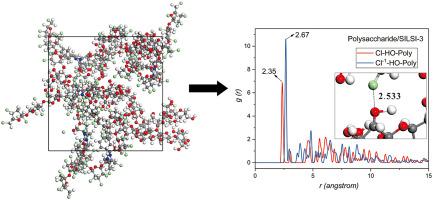Polymer ( IF 4.1 ) Pub Date : 2021-01-08 , DOI: 10.1016/j.polymer.2021.123388 Lijun Yang , Yibin Yang , Tianshi Li , Yao Xiao , Lixia Bao , Jiliang Wang

|
Polysaccharide like starch is the most promising green and sustainable packaging materials to replace fossil fuel based polymer. However, it is still a big challenge to directly make polysaccharide to be thermally plasticized due to its intense intra- and inter-molecular hydrogen bonds. In our previous studies, we have found that the addition of some specially designed chloride-contained organic compounds (named as supramolecular inducer) in thermal processing directly results in thermoplasticization of crop straw and corn starch like polysaccharides, yet the detailed thermoplasticization mechanism at molecular level is not fully understand. Herein, we extensively evaluate the potential thermoplasticization mechanism of polysaccharide thermally blended with different saccharide-based ionic liquid supramolecular inducers at molecular level via density functional theory and molecular dynamics simulations. Relevant results reveal that there are intense intra- (ca. 45.97 kcal mol−1) and inter-molecular (ca. 59.34 kcal mol−1) interactions in the neat polysaccharide macromolecules, leading to thermally unplasticizable of polysaccharide materials. Intense interactions between chloride atoms bonded on the supramolecular inducer and hydroxyl groups of polysaccharide macromolecules are observed, which are even stronger than these between chloride anions and hydroxyl groups of polysaccharides. Introduction of chloride atoms into supramolecular inducers is more facilitated to enhance the thermoplasticization of polysaccharide molecules in comparison with the chloride anions only supramolecular inducers. This investigation supplies an avenue to deeply understand the thermoplasticization mechanism of polysaccharide molecules, and is helpful to develop novel thermoplasticized polysaccharide packaging materials.
中文翻译:

通过计算机模拟了解分子水平上多糖的热塑性化机理
淀粉等多糖是替代矿物燃料基聚合物的最有前途的绿色和可持续包装材料。然而,由于其强烈的分子内和分子间氢键,直接使多糖热塑化仍然是一个很大的挑战。在我们以前的研究中,我们发现在热处理过程中添加一些经过特殊设计的含氯化物的有机化合物(称为超分子诱导剂)可直接导致农作物秸秆和玉米淀粉的增塑,如多糖,但在分子水平上却具有详细的增塑机理尚未完全了解。在这里 我们通过密度泛函理论和分子动力学模拟,在分子水平上广泛评估了与不同糖基离子液体超分子诱导剂热共混的多糖的潜在热塑性机理。相关结果表明,存在强烈的内(约45.97 kcal mol-1)和分子间(约59.34 kcal mol -1)在纯多糖大分子中相互作用,导致多糖材料无法热塑化。观察到超分子诱导剂上键合的氯原子与多糖大分子的羟基之间的强烈相互作用,甚至比氯离子与多糖的羟基之间的相互作用更强。与仅超分子诱导物的氯离子相比,将氯原子引入超分子诱导物更有助于增强多糖分子的热塑性。这项研究为深入了解多糖分子的增塑机理提供了一条途径,有助于开发新型的热塑性多糖包装材料。










































 京公网安备 11010802027423号
京公网安备 11010802027423号